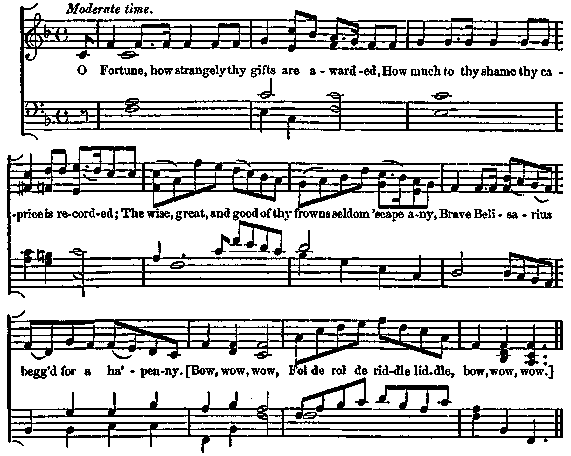Popular Music Of The Olden Time Vol 2
Ancient Songs, Ballads, & Dance Tunes, Sheet Music & Lyrics - online book
| Share page | Visit Us On FB |
|
|
|||
|
718 |
ENGLISH SONG AND BALLAD MUSIC. |
||
|
|
|||
|
Two versions of the tune were printed in National English Airs, The following is the older.
Having lost the transcript of the words of " The Barking Barber," the first four lines of " Date obolum " are printed with the tune. |
|||
|
|
|||
 |
|||
|
|
|||
|
NANCY DAWSON. |
|||
|
|
|||
|
Nancy Dawson, from whom this tune is named, was a celebrated dancer in the reign of George II. One of her portraits is at the Garrick Club; and there are four different prints of her, one of which, by Spooner, is in Dr. Burney's Collection of Theatrical Portraits in the British Museum. Another is by G. Pulley (folio), dancing a hornpipe, with the song; and a third by Watson. Her life was published in 1760; and Stevens's Dramatic History of Master Edward, Miss Ann, and others, " the extraordinaries of these times," was " a satire upon Edward Shuter, the comedian, and Nancy Dawson, the far-famed toast." From this work it appears that she first appeared, as a dancer, at Sadler's Wells; and as " she was extremely agreeable in her figure, and the novelty of her dancing added to it, with her excellence in her execution, she soon grew to be a favorite with the town; and at the ensuing season was engaged at Covent Garden playhouse. She became vastly celebrated, admired, imitated, and followed by everybody." Her death took place at Hampstead on 27th May, 1767, and she was buried in the Chapel of St. George the Martyr, Queen Square, Bloomsbury, where there is a tombstone to her memory, with the laconic inscription, "Here lies Nancy Dawson." She had many good qualities, and among others was very charitable. |
|||
|
|
|||